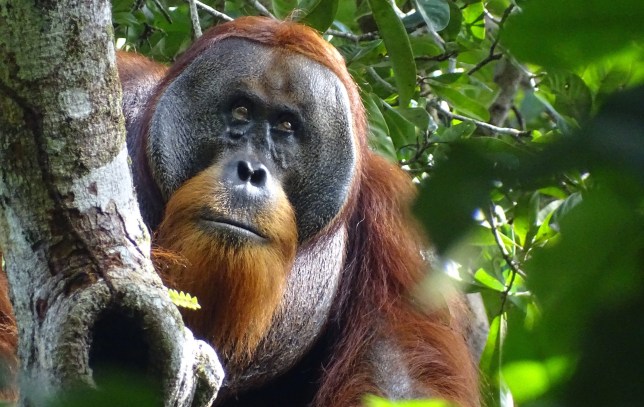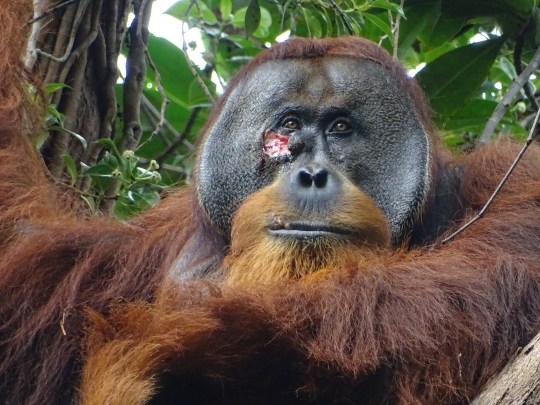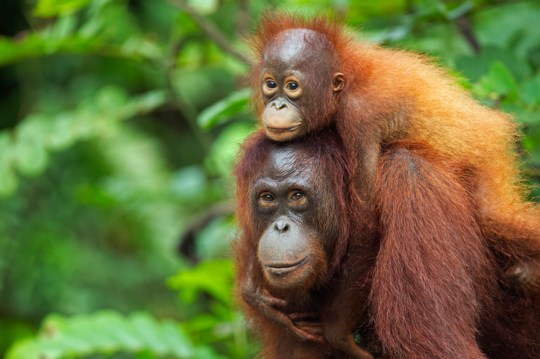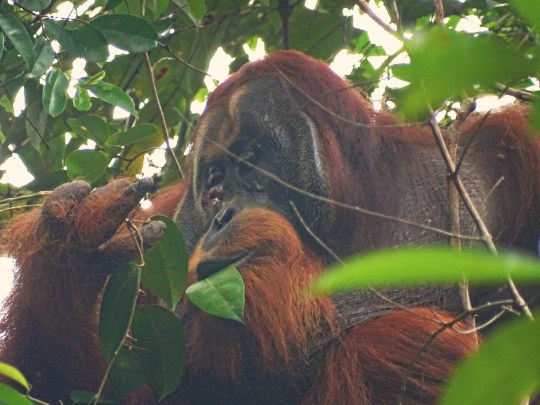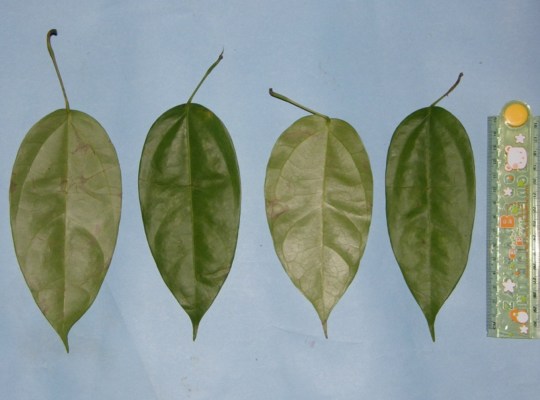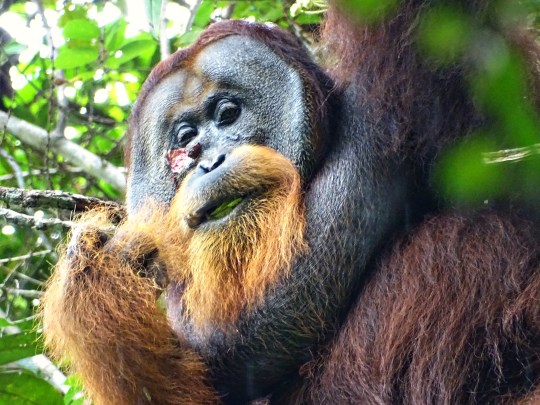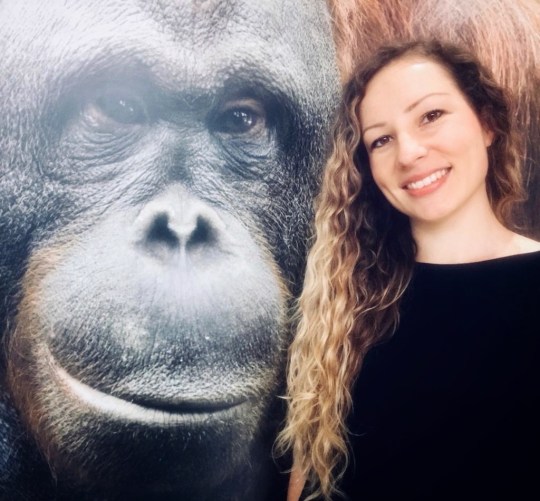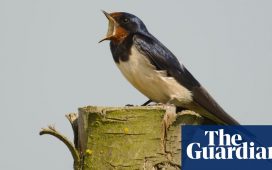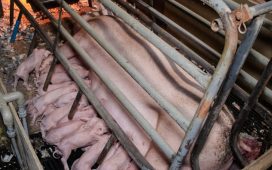In Disney’s the Jungle Book, the orangutan King Louie famously sings how much he wants to be like young human Mowgli.
Now it seems the real apes are even more like people than previously thought. In an incredible world first, a male orangutan has been seen repeatedly treating a wound using medicinal plants.
The wild male Sumatran orangutan, known as Rakus, was seen chewing leaves and applying the sap to a wound on his face. He then smeared the chewed-up leaves over the injury like a gauze.
The plant, Akar Kuning, has anti-inflammatory and pain-relieving properties. It is used in traditional medicine to treat conditions including diabetes, dysentery and malaria.
Five days after treatment there was no sign of infection and the large wound had closed. It was fully healed within a month, leaving Rakus feeling in fine fettle and back to his usual handsome self.
The findings, published in the journal Scientific Reports, are the first to show a wild animal using a plant with known medicinal properties for healing purposes.
However, it has long been known that orangutans are highly intelligent, having been seen to use tools, recognise themselves in a mirror, solve problems and plan in advance.
Dr Isabelle Laumer and her colleagues saw the astonishing behaviour while observing orangutans in the protected Suaq Balimbing research site within Gunung Leuser National Park, Indonesia, in 2022. It is home to around 150 critically endangered Sumatran orangutans.
She said Rakus chewed Akar Kuning stem and leaves and repeatedly applied the liquid generated onto a wound on his right cheek for seven minutes. He had sustained the injury three days earlier, probably in a fight with another male.
Dr Laumer, from the Max Planck Institute of Animal Behaviour, Germany, said Rakus then smeared the chewed leaves onto the wound until it was fully covered, and continued feeding on the plant for over 30 minutes. Other orangutans have rarely been seen eating it, suggesting it is not normally on the menu.
As Rakus applied the plant only to his wound, and no other body parts, over a long period, the team believes he was intentionally treating his facial wound with Akar Kuning.
How he learnt this behaviour, however, is still a bit of a mystery.
Bornean orangutans have previously been seen eating certain plants with particular health benefits, such as antibacterial properties, and have also been spotted chewing Dracaena cantleyi leaves and rubbing them on their arms and legs. Dracaena cantleyi is used by indigenous people to treat sore muscles and joint pain.
Orangutans: the lowdown
Known for their distinctive red fur, orangutans are the largest arboreal mammal, spending most of their time in trees. Long, powerful arms and grasping hands and feet allow them to move through the branches.
The name orangutan means ‘man of the forest’ in the Malay language.
These great apes share 96.4% of our genes and are highly intelligent creatures.
Orangutans live about 35 to 40 years.
Adult male orangutans can weigh up to 90kg.
There are three species of orangutan – Sumatran, Bornean and Tapanuli.
All are critically endangered due to habitat loss and illegal hunting.
Chimpanzees have been known to chew the bitter leaves of Vernonia amygdalina, thought to be to treat worms, while a troop in Gabon was recently observed applying insects to wounds.
The research team believes that wound treatment may have arisen in a common ancestor shared by humans and great apes, but this has not been proven.
Analysis of the leaves used by Rakus, known scientifically as Fibraurea tinctoria, revealed the plant has many benefits.
Dr Laumer said: ‘This and related liana species that can be found in tropical forests of Southeast Asia are known for their analgesic [pain-relieving] and antipyretic [fever-reducing] effects, and are used in traditional medicine to treat various diseases, such as malaria.
‘Analyses of plant chemical compounds show the presence of furanoditerpenoids and protoberberine alkaloids, which are known to have antibacterial, anti-inflammatory, anti-fungal, antioxidant, and other biological activities of relevance to wound healing.’
She added that Rakus also rested more than usual while he was wounded.
‘Sleep positively affects wound healing as growth hormone release, protein synthesis and cell division are increased during sleep,’ she said.
‘The behaviour of Rakus appeared to be intentional as he selectively treated his facial wound on his right flange [cheek], and no other body parts, with the plant juice.
‘The behaviour was also repeated several times, not only with the plant juice but also later with more solid plant material until the wound was fully covered.
‘The entire process took a considerable amount of time.’
Study senior author Doctor Caroline Schuppli, also of the Max Planck Institute, added: ‘It is possible that wound treatment with Fibraurea tinctoria by the orangutans at Suaq emerges through individual innovation.
‘Orangutans at the site rarely eat the plant. However, individuals may accidentally touch their wounds while feeding on this plant and thus unintentionally apply the plant’s juice to their wounds.
‘As Fibraurea tinctoria has potent analgesic effects, individuals may feel an immediate pain release, causing them to repeat the behaviour several times.’
She said that since the behaviour has not been observed before, it may be that wound treatment with plants was not part of the Suaq orangutan population.
Like all adult males in the area, Rakus was not born in Suaq, and his origin is unknown.
‘Orangutan males disperse from their natal [birth] area during or after puberty over long distances, to either establish a new home range in another area or move between other’s home ranges,’ said Dr Schuppli.
‘Therefore, it is possible that the behaviour is shown by more individuals in his natal population outside the Suaq research area.’
She added that the treatment of human wounds was most likely first mentioned in a medical manuscript that dates back to 2200 BCE, and included cleaning, plastering, and bandaging of wounds with certain wound care substances.
‘As forms of active wound treatment are not just human, it is possible that there exists a common underlying mechanism for the recognition and application of substances with medical or functional properties to wounds, and that our last common ancestor already showed similar forms of ointment behaviour.’
The research team said that they had not observed other orangutans within the study area treating their wounds, but that may be because they rarely encounter injured apes.
MORE : What is ‘love brain’, the disorder that left a teen in hospital?
MORE : First picture of teenager shot dead in ‘burglary gone wrong’
MORE : Olly Alexander gets crushing blow week before representing UK at Eurovision
Get your need-to-know
latest news, feel-good stories, analysis and more
This site is protected by reCAPTCHA and the Google Privacy Policy and Terms of Service apply.

